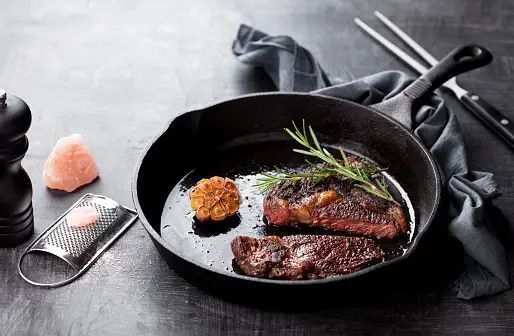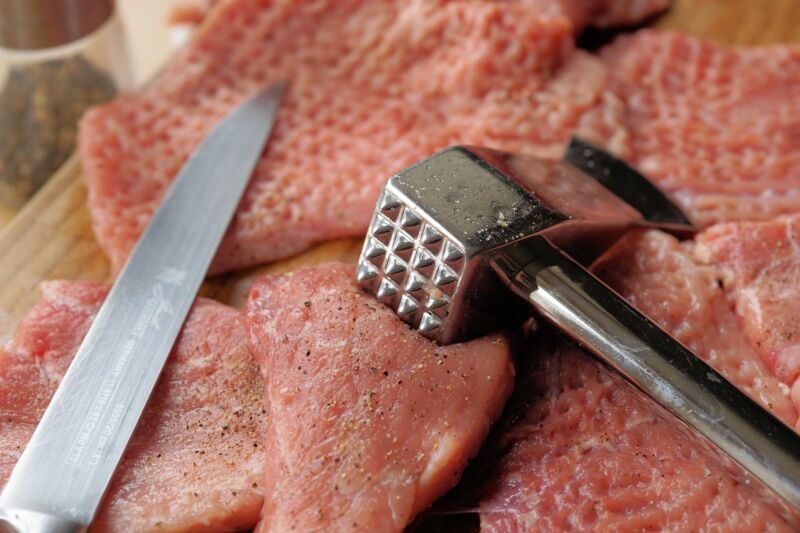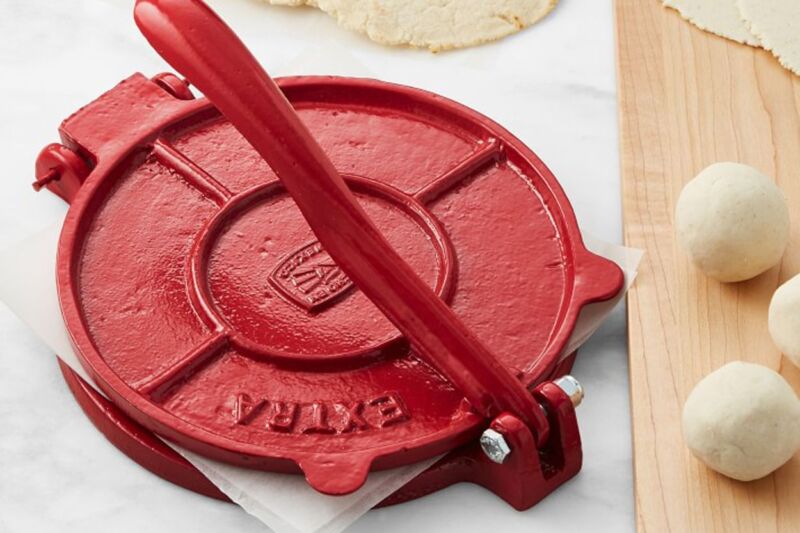TOP 8 Meat Mallet Substitutes for Tenderizing Meat
When it comes to cooking meat, tenderizing is an essential step to ensure a delicious and enjoyable dining experience. Meat tenderizers, such as meat mallets, play a crucial role in breaking down the tough fibers of meat, making it more tender and easier to chew. However, there may be instances when you find yourself without a meat mallet in your kitchen. In such cases, it’s helpful to know about meat mallet substitutes that can be used to achieve similar results.
What Is A Meat Mallet?
A meat mallet is a kitchen tool specifically designed for tenderizing meat. It typically consists of a long handle and a flat blunt head. Materials used to make meat mallets can vary, with wood, metal, and plastic being common choices. The design of a meat mallet allows for controlled force to be applied to the meat, breaking down its tough fibers and making it more tender.
The uses of a meat mallet in cooking are diverse. Firstly, it is commonly used for tenderizing tough cuts of meat. By pounding the meat with the mallet, the muscle fibers are broken down, resulting in a more tender texture. Secondly, a meat mallet can be used for flattening chicken breasts or cutlets. This ensures even cooking and reduces cooking time. Lastly, a meat mallet can also be used for crushing garlic cloves or other ingredients. Its flat head provides a convenient surface for crushing and releasing the flavors of various ingredients.
TOP 8 Meat Mallet Substitutes for Tenderizing Meat
While a meat mallet is a handy tool to have in the kitchen, there are alternatives that can be used as substitutes when one is not available. Here are 8 ideal meat mallet substitutes:
Cast Iron Skillet

A cast iron skillet can serve as an excellent substitute for a meat mallet. Its heavy and flat surface makes it suitable for tenderizing meat. To use it as a substitute, simply place the meat on the skillet and pound it with the flat side. The weight and surface area of the skillet will help break down the tough fibers of the meat, resulting in a tenderized texture.
Mortar
If you have a mortar and pestle in your kitchen, you have another option for tenderizing meat. A mortar is a bowl-shaped tool, usually made of stone or ceramic, used in conjunction with a pestle for grinding food. To use it as a meat mallet substitute, simply place the meat in the mortar and use the pestle to grind it up. This method is particularly useful for tougher cuts of meat, as the grinding action helps break down the fibers and make the meat more tender.
Papaya Pulp
For a natural and flavorful meat tenderizer, consider using papaya pulp. Papaya contains enzymes, such as papain, that have the ability to break down tough meat fibers. To use papaya pulp as a substitute, simply add it to your marinade or rub. The enzymes in the papaya will work their magic, helping to tenderize the meat and infuse it with a subtle tropical flavor.
Knife

Believe it or not, a simple kitchen knife can also be used as a meat mallet substitute. The flat side of the blade or the handle can be used to tenderize meat. To use a knife as a substitute, stroke the meat with the flat side of the blade or use the handle to pound it gently. While this method may require a bit more finesse and control, it can still help break down the tough fibers of the meat and make it more tender.
Baking Soda
Baking soda, with its alkaline properties, can also be used as a meat mallet substitute. When added to a marinade, baking soda helps to tenderize the meat by breaking down its proteins. To use it as a substitute, add baking soda to the marinade and let it sit for a period of time. The baking soda will work its magic, making the meat more tender and flavorful.
It’s important to note that while these substitutes can be effective, they may not provide the same level of control and precision as a meat mallet. Therefore, it’s advisable to adjust the amount of force and duration of pounding according to the desired tenderness of the meat.
Rolling Pin
Another meat mallet alternative that can be found in many kitchens is a rolling pin. This cylindrical tool with handles is commonly used for rolling out dough, but it can also serve as a handy meat tenderizer. To use a rolling pin as a substitute, simply place the meat on a cutting board and roll the pin over it. The weight and pressure applied by the rolling pin will help break down the tough fibers of the meat, resulting in a tenderized texture.
Tortilla Press

A tortilla press, typically used for making tortillas, can also be repurposed as a meat mallet substitute. This flat, heavy press is perfect for flattening meat. To use it as a substitute, position the meat between plastic wrap to prevent sticking, and then use the press to flatten it. The weight and even distribution of pressure from the tortilla press will help tenderize the meat and create an even thickness.
Marinades
Lastly, marinades can be an effective substitute for a meat mallet. Marinades typically consist of acidic juices like lemon juice or vinegar, which help break down tough fibers in the meat. To use a marinade as a substitute, simply marinate the meat for a period of time. The acid in the marinade will gradually tenderize the meat, resulting in a more flavorful and tender dish.
Meat Tenderizer Substitute For Jerky
When it comes to making jerky, tenderizing the meat is crucial to achieve the desired texture. If you don’t have a meat mallet on hand, there are alternative methods you can use to tenderize the meat:
Vinegar or Lemon Juice
One effective method is to soak the meat in vinegar or lemon juice before marinating it. The acidity in these liquids helps break down the tough fibers of the meat, resulting in a more tender jerky. Simply place the meat in a bowl and cover it with vinegar or lemon juice, allowing it to soak for a period of time before proceeding with the marinade.
Food Processor
Another option is to use a food processor to grind the meat into a finer consistency. By pulsing the meat in the food processor, you can break down the fibers and create a more tender texture. This method is particularly useful if you prefer a softer jerky or if you have tougher cuts of meat that require more tenderizing.
Pounding the Meat
If you have a heavy object or a meat mallet substitute, you can also try pounding the meat to break down the fibers and make it more tender. Place the meat between plastic wrap or in a resealable bag to prevent any mess, and then use a mallet or another heavy object to gently pound the meat. This method helps to tenderize the meat and create a more uniform texture for your jerky.
How Do You Flatten Chicken Breasts Without A Mallet?
Flattening chicken breasts is a common technique used in various recipes, such as chicken schnitzel or stuffed chicken. If you don’t have a meat mallet, there are alternative methods you can use to achieve the desired result:
Using a Heavy Skillet
One option is to use a heavy skillet as a substitute for a meat mallet. Place the chicken breast on a cutting board and use the flat side of the skillet to gently pound the chicken breast until it reaches the desired thickness. The weight and surface area of the skillet help to flatten the chicken breast evenly.
Using a Rolling Pin
Another alternative is to use a rolling pin. Place the chicken breast on a cutting board and use the rolling pin to roll over the chicken breast until it is flattened to the desired thickness. This method allows for even pressure distribution and ensures that the chicken breast is flattened uniformly.
Using a Wine Bottle
If you don’t have a rolling pin or a heavy skillet, you can use a wine bottle as a substitute. Place the chicken breast in a resealable bag to prevent any mess, and then gently hit it with the bottom of the wine bottle until it is flattened to the desired thickness. This method requires a bit more caution, but it can be effective in achieving a flattened chicken breast.
How Do I Choose A Meat Mallet?
When selecting a meat mallet, there are several factors to consider to ensure you choose the right one for your needs:
Size, Weight, and Material
It’s important to examine the size, weight, and material of the meat mallet. The size should be suitable for the types of meat you typically cook, allowing for effective flattening or tenderizing. The weight should be comfortable for you to handle without straining your wrist or arm. As for the material, stainless steel or non-rusting metal is ideal for metal mallets, while hardwood like maple or oak is preferred for wooden mallets.
Grip
The grip of the meat mallet is also important. Look for a mallet with a comfortable grip that allows for easy and secure handling. This will ensure that you have control over the mallet and can apply the desired amount of force when tenderizing or flattening meat.
Conclusion
In conclusion, when a meat mallet is not available, there are various alternatives that can be used as substitutes. Vinegar or lemon juice, a food processor, pounding with a heavy object, using a skillet, rolling pin, wine bottle, or other kitchen tools can all serve as effective substitutes for a meat mallet. When choosing a meat mallet, consider factors such as size, weight, material, and grip to ensure it meets your specific needs. By exploring these alternatives and selecting the right tool for the job, you can still achieve tender and flavorful meat dishes in your kitchen.






